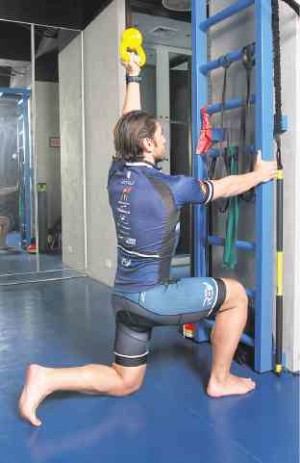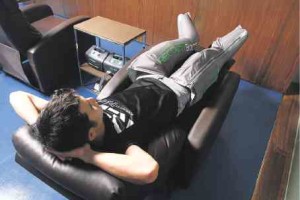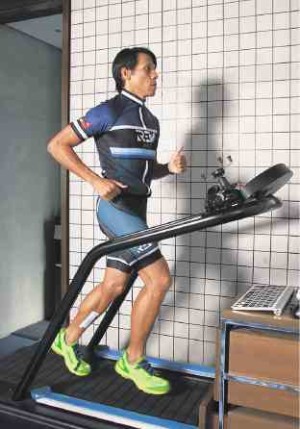
WHEN triathlete Enrico Manichetti hits another long course in IronMan Barcelona on Oct. 2, he would be in top shape—thanks to diet, training and rest.
Sports physiologist Francis Diano, head of Pace Prehab and Recovery, put him on a lifestyle of right attitude, nutrition and correct movement. The program aimed to help people reach their peak performance.
In the past, Manichetti would experience painful calf muscles as the volume and intensity of his training increased. Instead of enduring the pain, he worked smarter.
“If there is discomfort, I need to back down and make sure that none of the tissue tension is building up,” said Menichetti.
Diano recommended reducing Menichetti’s volume of exercise and substituting other drills. Since triathlon courses are linear, Menichetti balances the overtaxed muscles by working out in a different direction and change the way muscles are used. After the workout, he relaxes with compression boots to massage his tired legs.
Diet plays an important factor. When Menichetti was girding for Ironman Arizona in 2015, Diano put him on a balanced nutrition program. “Instead of him relying on sugars and energy drink, his body is trained to use up its own energy to burn more fats,” said Diano.

Pace Prehab and Recovery not only prepares athletes for events, it also helps seniors, persons with disabilities (PWD) and moms who want to to be mobile. Pace’s program will help them reduce chronic pain, boost their energy and improve their muscle tone.
After the initial screening for stress, muscular and stability imbalances, a customized program will include exercises that prevent injuries and therapies that speed up muscle recovery.
Shoulder pain
It all began in 2014. Triathlete Iah Isip was girding for the Ironman 70.3 Princeton in New Jersey and the New York Marathon. Ironically, he couldn’t run or walk properly.
The wear and tear of training took a toll on his feet. He also complained of shoulder pain as he made the transition from swimming to biking.
Fil-Am coach Arland Macasieb recommended his client to Diano, who was then based in New York and was touted as one of the top sports and manual orthopaedic therapists.
“My job in New York was to figure out complex issues for surgeons and athletes. I look at the person as a whole not as a body part,” said Diano.
To address Isip’s foot pain, Diano redesigned the running shoe footbed which was more detailed than the orthotics, a customized insert that redistributed the body weight and realigns the joints. The new footbed aimed to correct the foot functions, reduce the pain and allow greater movement.
For Isip’s back problem, Diano looked into how his client’s muscles weren’t firing correctly. After sessions of Clinical Pilates and manual therapy, Isip competed in the Ironman 70.3 and New York Marathon without a hitch.
Isip was impressed with Diano’s methods that he recommended Diano to his colleague, Steve Vesagas, who was also joining the New York Marathon 2014. Vesagas had over-trained by running and working out relentlessly all without appropriate recovery.
“We needed to speed up his recovery by identifying which muscles gave him pain. We worked on improving flexibility and circulation,” recalled Diano. Vesagas underwent manual therapy and soft-tissue mobilization.
Regeneration
Regeneration is one of the main elements of the program, said operations director Shirley “Shy” Sison-Vesagas. The program educates clients on recovery as the means when the body actually adapts and gets stronger.
The lawyer-triathlete learned to cycle recently under the tutelage of Diano. “We don’t abuse our bodies,” said Shy. “The training is properly spaced. I’ve been training daily except on Thursday. Francis insists on skipping a training day and getting eight hours of sleep so that the body can recover.”
At Pace, Shy hopped on the CompuTrainer, an indoor bicycle with software that recorded the cyclist’s power and cadence. “It can simulate race courses that can help you build strength especially if you are new to cycling,” he said.

Dan Layug swore by the Woodway treadmill looped by shock-absorbing wooden slats. “It saved my knees. Whenever I ran over 21 km, my knees would twinge that I had to take off the next day. I could run the next day with this treadmill,” he said.
After his workout, he plopped into a recliner and watch TV while wearing pneumatic boots to massage his leg. The compression kneaded out the excess lactic acid to prevent soreness.
“I can add more load to the body without my knees buckling down,” said Layug who is girding for the Chicago Marathon on Oct. 10.
Road map
Swim coach Victor Benjamin “Noy” Basa was initially treated for soreness on the plantar fascia, the ligament that supported the arch, which was often bruited by running. Basa is also girding for the Vietnam Challenge. He also wore the recovery boots to reduce muscle soreness after a tough workout.

Diano gave his trainees the tools to facilitate certain movements. Many of the exercises can be done at home, he said.
He compared the client’s program to a road map. “What adjustments do we make along the way? If there are tight areas, can we stretch or strengthen them? Has your body changed after six weeks into the program? The idea is to keep the person in check.”
Diano explained that it would take four sessions to prevent injury compared with 14 sessions of rehabilitation.
“When the body gets hurt, its movement changes,” he said. “The case becomes difficult because you’re not just fixing the problem area. The cause may come from somewhere else. We want to give the client the ability to remove the potential causes and what to do if they get hurt.”
ACE Prehab & Recovery is at 16/F, MDI Corporate Center, 10th Ave. corner 39th St., Bonifacio Global City. Call 0915-6783600.












































